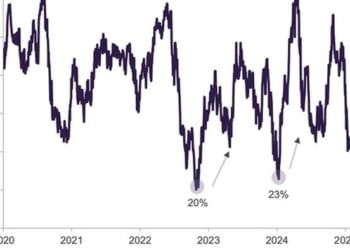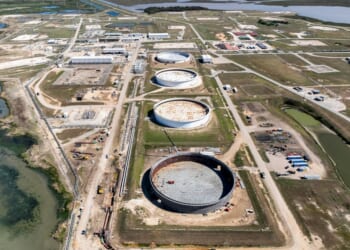California, by far the largest state by student population, just released its chronic absenteeism data from last year, making it the 28th state to do so.
Before the pandemic California’s absenteeism rate hovered around 12 percent—lower than the national average—but when chronic absenteeism spiked across the nation in 2022, California’s chronic absenteeism rate jumped to 30 percent. That 240 percent increase was the largest relative increase in the nation.
California’s attendance recovery has been outsized as well. The state’s chronic absenteeism rate dropped five percentage points in 2023 and by 4.5 percentage points in 2024. Across two years, that relative decline of 30 percent was unprecedented—and especially impressive considering that California educates with roughly six million students.
Last year, however, California continued that decline but at a much slower pace, dropping only one point to 19.8 percent. (This is the student weighted average across districts, which is the calculation I use for cross state comparisons in my Return to Learn Tracker. This figure differs slightly from the state’s published figure of 19.4 percent, which removes students duplicated across districts.)
Unfortunately, this slowdown is evident across the nation. In fact, well over half the 29 states with data from the 2024–25 school year at the Return to Learn Tracker show a similar deceleration. However, California’s deceleration is notable because of how much recent progress it had made.
Breaking down the data a bit suggests the slowdown was widespread. The chart below shows all California districts divided into high, medium and low achievement. It is plain that both before and after the pandemic, higher achieving districts had lower absenteeism, but what’s also plain is that all three groups show the same trajectory over time: similar large pandemic jumps (at least proportional to their pre-pandemic baseline), similar post pandemic declines through 2024, and a similar deceleration last year.

Events peculiar to California over the last year might explain this deceleration, particularly wildfires and increased immigration enforcement activity, the latter of which has been shown to affect attendance. Both of these may be working against attendance, but does that mean they drove the change in California’s attendance trend?
Below I compare student-weighted changes in attendance in 18 counties that had a substantial wildfire (covering at least 5,000 acres) last year with California counties that did not.
I also look at how attendance—both of all students and of migrant students—in California counties where press reports (gathered through ChatGPT or Gemini queries) noted heightened ICE activity in the spring of 2025 compared with attendance in other counties. Admittedly, both of these are quick and dirty comparisons, but they should display differences if either wildfires or immigration enforcement were major drivers of absences.

The question at hand is whether counties plagued by wildfires or immigration enforcement showed dissimilar trajectories between the last two school years, 2023–24 and 2024–25. With regard to immigration enforcement, it is plain from the graph above that counties with noted immigration enforcement, referred to for ease as ICE activity, made little difference to that trajectory for all students. For students California classifies as migrant students, we might expect a larger effect, but even among these students (weighted by each district’s migrant student population) the recent trajectory is similar, maybe even a bit better, in counties with more notable immigration enforcement activities. This is not evidence that ICE activity does not affect students’ attendance, but it does pour cold water on the suggestions that such activity explains the California’s slowed progress on attendance.

Likewise, wildfires were potent last year in California, but in districts that experienced large wildfires during the school year, we again see little difference in the change in attendance trajectories. In fact, the slopes for both average absences and chronic absenteeism decline are nearly identical. Both are improving, but more slowly and in tandem.

The takeaway here is not that wildfires and immigration enforcement have no impact on attendance in the 2025 school year—I believe both do. Rather, it’s that last year’s larger slowdown in progress on attendance is not easily attributable to novel external factors.
California and most other states that show a similar slowdown still have a great deal of work to do to return to acceptable levels of attendance. That work has to focus on the everyday behaviors of most California schools, families and students, and no quarter should be given to explanations that might distract us from maintaining focus on the hard work left to be done.
The post Did ICE Raids and Wildfires Slow California’s Progress on Student Absenteeism? appeared first on American Enterprise Institute – AEI.














